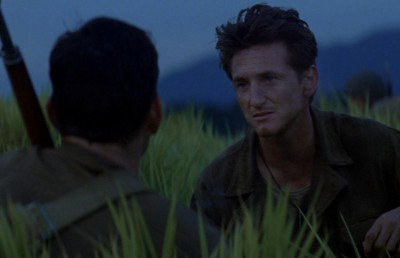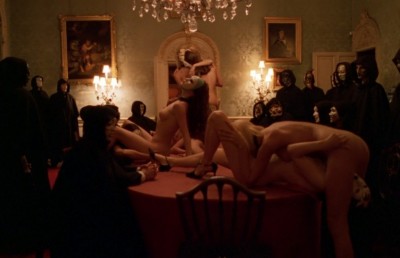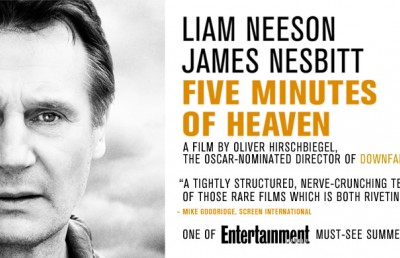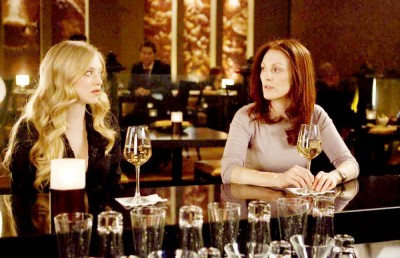Collateral: A Case Study in Ethical Subjectivity
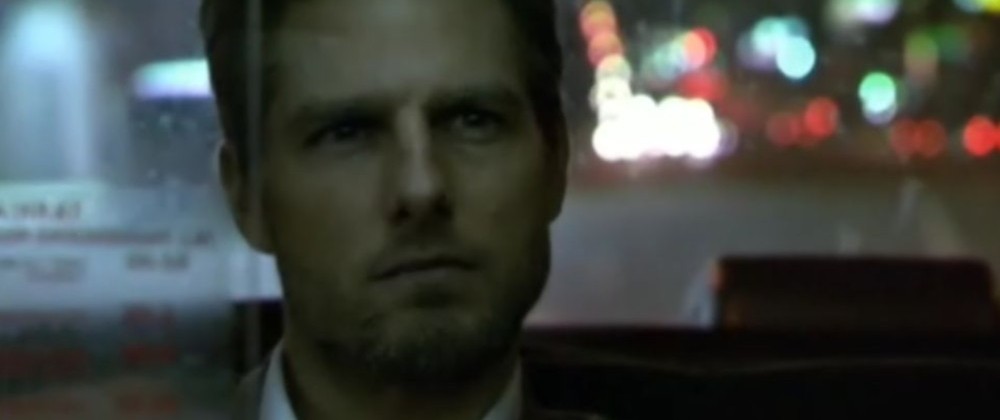
From the earliest days of filmmaking through to the modern era, the landscape of urban America has pervaded all eras of cinema. As far as modern Hollywood cinema is concerned, Martin Scorsese certainly makes a strong case for being the king of New York, while Christopher Nolan is doing a lot to take the baton from action auteur Andrew Davis and make Chicago his cinematic home turf. When it comes to the best filmic treatments of Los Angeles, the list of contenders would be incomplete without including Michael Mann, the “pre-eminent mythologizer of contemporary L.A.” (Glaister, 2004). Indeed, were one to solely use Heat and Collateral as ammunition, it would be very easy to shoot down a majority, if not all, of the competition. Mann has always been fascinated by Los Angeles, and Collateral serves as an “apocalyptic vision of the world’s premier post-industrial sprawl as it sleeps unaware of its own rancid dreams” (Atkinson, 2004).
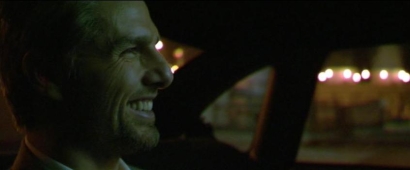
Title Picture
A masterful storyteller, Mann moonlights in Collateral as a Los Angeles tour guide, taking his audience on a nighttime journey that serves as an “eschatological gift to the cataclysmically inclined” (Saunders, 2009: 71), moving through the heart of the city amidst the towering skyscrapers down into dimly lit back alleys near cheap motels on the outskirts of civilization. The genre in which Mann is working is, at its vaguest and most inclusive, the “urban drama,” which can be specified further to “crime drama” or “neo-noir.” However, as Roger Ebert perceptively notes, Mann “deepens genre through the kind of specific detail” (Ebert, 2004) one would expect in the work of an auteur, and Mann, throughout his career, has effectively affixed genre study with auteurist analysis. In Collateral, Mann returns to many of his most familiar themes while exemplifying genre filmmaking from the broadest standpoint of the urban drama to the most specific standpoint of a post-modern, post-9/11 neo-noir thriller in the tradition of Robin Wood’s “incoherent text.”
On the surface, Collateral is ostensibly banal high-concept fare: Vincent (Tom Cruise), a contract killer, forces Max (Jamie Foxx), a Los Angeles cab driver, to drive him around the city all night while he kills five Federal witnesses set to testify against a drug lord. Deceptive in its density, however, Collateral is much more than its simplistic synopsis, offering Mann both “a platform for [his] authorial interests” (Anderson, 2004) as well as a chance, as noted by Ebert, to deepen what appears to be merely a frivolous exercise in genre filmmaking. From the perspective of genre, Collateral is similar to a great many urban dramas, but the two films with which Collateral has arguably the strongest connections are James Cameron’s science fiction classic, The Terminator, and Martin Scorsese’s landmark 1976 film, Taxi Driver, one of the films identified by Wood as an incoherent text.
To begin his examination of incoherence in 1970s filmmaking, Wood posits that “all traditional art has as its goal the ordering of experience, the striving for coherence; yet all art reveals, if one pursues the matter relentlessly enough, areas of incoherence” (Wood, 1986: 46). He goes on to make special mention of the fact that the films with which he is concerned are not films that utilize flashbacks, jumps in narratological temporality, extradiegetic episodes, or any other cinematic techniques used to disorient audiences. In Wood’s view, such films “become as coherent as any when one grasps their mode of functioning” (Wood, 1986: 47). Instead, the films with which he is concerned are those “that don’t wish to be, or to appear, incoherent but are so nonetheless, works in which the drive toward the ordering of experience has been visibly defeated” (Wood, 1986: 47).
These statements made in reference to films of the 1970s are inarguably applicable not only to Collateral, but to many of the films released subsequent to the terrorist attacks on the World Trade Center on September 11th, 2001. Through this prism, the intrinsic relativism of filmic and ideological incoherence is rendered explicit, and Wood promulgates the impact of ideological discourse on a text’s incoherence by situating his argument in the shadow of Vietnam, Watergate, Civil Rights violence, student protests, and all of the other sociopolitical discord of the era. In his discussion of film interpretation, William Cadbury notes how meaning in film is “in every respect something drawn from some sort of culturally established storehouse” (Cadbury, 1982: 191). This cultural “storehouse,” in Wood’s determination, is “the dividing line between coherent works that register incoherence and works that are incoherent within themselves” (Wood, 1986: 46). Collateral serves as a particularly unique incoherent text not just resultant from its connection to Taxi Driver on a narrative level, but from its connection to a similar state of sociopolitical confusion as during the making of Taxi Driver, forcing one to acknowledge the concomitance of ideological incoherence with filmic incoherence.
The first point Wood makes regarding Taxi Driver relates to its setting, referring to its grimy rendering of New York City as the “Excremental City” (Wood, 1986: 46). The connections between Tom Cruise’s contract killer and Robert De Niro’s disturbed cabbie are numerous, but one considerably overlooked connection is their commensurate discontent in returning to the locale in which the diegetic action takes place. Prompted by an innocuous question from Max during their first conversation, Vincent takes the first of many opportunities to esoterically wax philosophical, noting how, whenever he returns to Los Angeles, he cannot wait to leave. For him, the city is “too sprawled out, disconnected.” Characteristic of the post-modern, neo-noir mold in which Collateral was constructed, there is no place for idealism and love for your fellow man; likewise, in Taxi Driver, Travis, too, is unhappy to return, here not to Los Angeles from places unknown but to New York from fighting in Vietnam. Travis is disconcerted to find that he went off to fight a war in order to preserve the decadence of a place that he would much rather flush down the toilet. Travis views the urban decay of New York City from the same negative perspective as Los Angeles is viewed by the sociopathic Vincent, who has taken Travis’s disturbed desire to kill and made a career out of it.
A subsequent point made by Wood, perhaps the most interesting in regards to the implicit connections between Collateral and Taxi Driver, is the assertion that “the central incoherence in Taxi Driver lies in [the lack of a] consistent, and adequately rigorous, attitude to the protagonist” (Wood, 1986: 53). This idea of a character about whom the spectator is conflicted, consistently oscillating between rooting for their death and hoping for their survival, is of paramount interest in both films, especially Collateral, where Vincent is ostensibly the “bad guy,” painted in the early portion of the film as a Terminator-style killing machine programmed to kill five targets.
The diegetic shock of Vincent’s inherent evil, which comes in the form of the corpse of his first target alarmingly flying out of an apartment window and landing on the roof of Max’s cab [1], is followed by a second insight into Vincent’s evil nature as he threatens to kill two police officers that pull Max over after noticing the damage to his cab. These are all narrative cues provided to us in order to confirm that Vincent is the villain of the piece, just as the cold-blooded murders committed by the titular Terminator prove that he is the bad guy in James Cameron’s iconic science fiction actioner. Indeed, while the connections between Vincent and the legendary Teutonic automaton are not as plentiful or substantial as those with Travis Bickle, there are undoubtedly discernible parallels, the most significant parallel coming in the form of our irresolution in how to interpret their respective quests.
For all of the opportunities to condemn Vincent as a warped, disturbed, violent sociopath, the intrinsic incoherence within the character refuses to be subdued. Whether it is due entirely to the nature of the story and the character of Vincent as written or if there is perhaps an intertextual element based on the “hyperbolic star text” (Knapp, 2008) of Tom Cruise, spectatorial identification with Vincent is achieved numerous times throughout the film, and yet, just as profoundly, Mann succeeds in forcing us into a state of fear of Vincent and a desire for his death. This brings Collateral to a staggering level of incoherence, far beyond anything achieved with De Niro in Taxi Driver or even Arnold Schwarzenegger in The Terminator.
Speaking to star iconicity, Dave Saunders observes, during his sagacious examination of the Schwarzenegger iconography [2], how Schwarzenegger, as the titular villain of The Terminator, was inexplicably “playing like the hero” (Saunders, 2009: 68, citing Tom Shone). Similar to Collateral, it is unclear whether this is due to some failure on the part of the filmmakers or simply due to the power of the Arnie aura. Saunders argues that a possible explanation for this phenomenon in The Terminator is the failed attempts to invest in Michael Biehn’s character, who is supposed to be the hero, “ruggedly masculine, selflessly militaristic traits,” resulting in Biehn “never [becoming] a convincing foil for Arnold” (Saunders, 2009: 68). There is a weakness both in Biehn’s character Kyle Reese and, at least in the beginning of the film, in Max in Collateral, and when they are seen juxtaposed with such supremely efficient machines of action as the Terminator and Vincent, it becomes easier to envision an audience that “gravitates towards the character who has the aura of a hero” (French, 1996: 41). There is something universally appealing in what Saunders calls “the beauty of pure functionality” (Saunders, 2009: 65). He argues that The Terminator evokes “the Devil in all of us who find ourselves, against any logical judgment, sympathizing with Schwarzenegger—-the bringer of the end, an emissary of the Beast—-over his targets” (Saunders, 2009: 65).
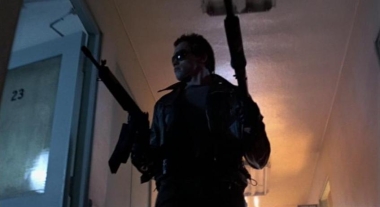
Terminator-as-Hero asserts his dominance in a shootout
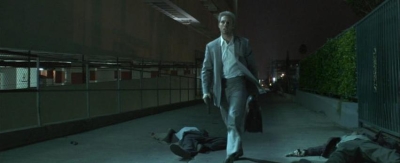
Vincent-as-Hero asserts his supremacy over two young muggers
From this vantage point, the response to Vincent in Collateral is identical. While logic would have us feeling pity for the helpless prey trapped in the urban frontier with the supreme predator in Vincent, we nevertheless come to identify with, even admire, the “battle-primed ideal” (Saunders, 2009: 65) he represents. We watch as Vincent, like the Terminator, “enters the City of Angels” and “takes what he needs and makes it his domain; he shows outlaws what it means truly to live by one’s own rules” (Saunders, 2009: 70). Cameron’s vision in The Terminator points to a future where “humankind will rediscover its soul after the ultimate sin: expending resources on fighting ideological wars abroad whilst ignoring immediate neighbors and the imminence of a doomsday wrought from [our own] civilization” (Saunders, 2009: 70-71), a future that unnervingly sounds a lot like our present. Here, the link between sociopolitical discord and narrative incoherence ties all three of these films together; where Collateral pulls away from Taxi Driver and The Terminator, though, is in its dialectical pursuit of a new standard of ethics by which to navigate through the world to which both Scorsese and Cameron, unlike Mann, seem “infinitely resigned” apropos of Kierkegaard.
In both Taxi Driver and The Terminator, there is on display what Wood describes as a “generalized crisis in ideological confidence” (Wood, 1986: 50). These films depict a process of decay within modern urbanity, and this zeitgeist is mirrored by the historicity of Collateral, which is not just a post-classical film noir but a post-9/11 film noir, the cynicism not restricted to capitalist/patriarchal ideology or political/corporate corruption, but cynicism regarding existence itself, cynicism regarding the notion that life (or death, for that matter) has meaning. Wood conveys his disappointment in how, from this 20th Century ideological crisis, our society “never issued in revolution,” that “no coherent social/economic program emerged,” and that “society appeared to be in a state of advanced disintegration [for which there was no] coherent and comprehensive alternative” (Wood, 1986: 50).
Mann’s vision in Collateral suggests that this process of decay and disintegration has seeped into the 21st Century, and it will not stop until society confronts it and issues in a revolution at last. It must not be overlooked, however, that this maxim of Mann’s is surprisingly optimistic considering its being situated in the intrinsically pessimistic world of film noir. To say that the process of societal decay will not stop until it is confronted implies, of course, that such a confrontation has the potential to stop the decay, that there exists a way to “cure” society. With Collateral, Mann is optimistically asserting that, while “the present moment appears as the lowest point in the long process of historical decadence […] the danger of the catastrophic loss of the essential dimension […] also opens up the possibility of a reversal” (Žižek , 2006: 76), the possibility of a revolution that initiates a new, coherent, and comprehensive alternative.
So, beyond his position as a “battle-primed ideal” of “the beauty of pure functionality,” as per Saunders, Vincent also serves as a perverse “subject supposed to know” posited by our confused post-9/11 society. The implication of Wood’s decree to find a “coherent and comprehensive alternative” to the sad state of society is that such an alternative exists. By the same token, there is an implication that there is someone out there who knows what this alternative is and how to bring our society into this new order. In the world of Collateral, this discourse is treated allegorically through the dialectical relationship between Vincent (the analyst) and Max (the analysand). Interspersed between the scenes of action as Vincent progresses through his hit list are several key conversations between Vincent and Max in Max’s cab. These “sessions” serve to highlight Mann’s “ethics of excess.”
As Todd McGowan asserts in his examination of the ethics in the Mann oeuvre, “Mann uses cinematic fantasy in order to make ethical subjectivity visible for us” (McGowan, 2007: 57). Moreover, his films prove that “the radicality of [his] fantasmatic cinema derives from its ability to facilitate identification with excess rather than retreat from it” (McGowan, 2007: 57). From this perspective, Mann has created, in Vincent, a quasi-Derridean figure tasked with showing the analysand Max the inherent yet traumatic potentiality in the transgression of the Law.
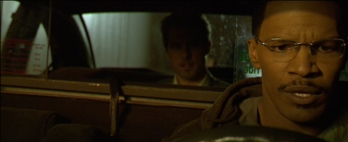
Vincent, the spectral analyst, haunting Max inside his cab
Speaking of the era of sociopolitical strife and subsequent ideological confusion in which he was formulating his concept of filmic incoherence, Wood posits the following:
The questioning of authority spread logically to a questioning of the entire social structure that validated it, and ultimately to patriarchy itself: social institutions, the family, the symbolic figures of the Father in all its manifestations, the Father interiorized as superego. The possibility suddenly opened up that the whole world might have to be recreated (Wood, 1986: 50).
During his first conversation with Max, Vincent attempts to convey to Max his negative thoughts about Los Angeles by recounting to him a story he heard about a guy who got on the M.T.A., died, and was not noticed for six hours, during which time people were continually getting on and off the train, even sitting next to him. This complete indifference, this absurdity and illogicality of life and death, reinforces Vincent’s nihilism, yet most intriguing of all, instead of serving as an obvious narrative cue for us to condemn Vincent for such a negative philosophy, it is this very philosophy that allows for such a strong identification with him. In Vincent, we are looking at a character who is not indulging in the ridiculous denial of the poor state of contemporary society. As noted by Slavoj Žižek, “we are dealing here with a kind of Hegelian reflexivity: what changes in the course of the hero’s ordeal is not only his character, but also the very ethical standard by which we measure his character” (Žižek, 2006: 27).
In the urban frontier, the dominant ideology will not suffice. Ideology as such is not enough to bring our society from out of the darkness and into the light. We must issue a revolution and adopt an entirely new ethical standard. It is according to this philosophy that Vincent operates, and it is because he operates according to such a philosophy, because he embodies each individual’s potential to transgress the Law and approach jouissance, that we can form such a connection to/with him, yet, paradoxically, it is also this radical belief system that causes, both in Max as well as the audience, the knee-jerk reaction of disavowal. In his discussion of the Master-Signifier and its vicissitudes, Žižek incorporates Derrida’s conception of “the Law [as] prohibition,” which continues as follows:
This does not mean that it prohibits, but that it is itself prohibited, a prohibited place […] one cannot reach the law, and in order to have a rapport of respect with it, one must not have a rapport with the law […] one must enter into relation only with the law’s representatives, its examples, its guardians. These are interrupters as much as messengers (Žižek, 2006: 39).
In this respect, the Law becomes “an impossible Real, a void which nonetheless functions, exerts influence, causes effects, curves the symbolic space” (Žižek, 2006: 39). The “crucial” ambiguity of Derrida’s assertion of the transcendent authority of the Law begs, for Žižek, such questioning of whether or not the transcendent authority of the Law can ever be defeated, whether it is possible “to fully assert that ‘it all depends only on me’” (Žižek, 2006: 39). Vincent, of course, is a living answer in the affirmative. As a Kantian “ethical narcissist” par excellence, Vincent is that which Max cannot become, but that which Vincent is helping Max see, through their unique “sessions” in the cab, is actually that which, as Žižek would say, is “in Max more than himself.” Žižek describes the Kantian notion of ethical narcissism as “following one’s ethical principles independently of consequences in the real world, of rejecting consequences as the criterion of moral value […] of insisting on the purity of my Will, of my intention, as the ultimate criterion” (Žižek, 2006: 47). If, according to McGowan, the “excess that exists at the heart of Mann’s films is that of subjectivity itself, or, which is to say the same thing, the ability of the subject to attach itself exclusively to its duty,” and if Mann’s films “call us to value duty in precisely this way” (McGowan, 2007: 58), then Vincent is the ultimate representative of this concern. He demonstrates better than any other Mann character the “beauty of pure functionality” apropos of Saunders, and in this respect, serves as Max’s perfect doppelgänger.
Discussing the anxiety that comes from encountering one’s double, Žižek posits the following:
The true point of anxiety is thus not that of doubling my body, but that of doubling my unique Soul. What makes me creep at the very thought of encountering my double is not that he looks exactly like me, but that, in his personality, he ‘is’ another me, that he clones the very uniqueness of my personality (Žižek, 1999: 316).
Thus, the significance of the initial bond between Vincent and Max over Max’s successfully transporting Vincent to his desired location in seven minutes just as he said he would (i.e., over their mutual appreciation of doing one’s duty to the best of one’s ability) cannot be overlooked. Following this initial doubling, several more instances occur that situate Max much closer to Vincent than he would like to admit, and it is because of this doubling effect at work that Vincent is an even more traumatic figure for Max than merely as the analyst. Vincent embodies both the “subject supposed to know” as well as “that which is in me more than myself,” and the trauma of encountering this spectral and transgressive Derridean double is what allows Max to emerge as a proper subject. As Žižek argues, the subject emerges “not via subjectivization-narrativization, i.e., via the individual myth constructed from the decentered pieces of tradition; instead, the subject emerges at the very moment when the individual loses its support in the network of tradition” (Žižek, 1993: 42).
This emergence of Max-as-Subject comes at the turning point in the narrative, which, significantly, is the point in the narrative where Max stops disavowing and instead embraces the Vincent within him. Following the film’s ultimate set-piece, Max has finally reached his breaking point. Something has got to give in this bizarre session of analysis to which he has been subjected by Vincent, and he has reached a point mentally where he is ready to end his analysis by de-supposing Vincent of knowledge and removing his analyst from the exalted position of the subject supposed to know. Max attempts to expose Vincent’s position of believing that our life has no and needs no “transcendent Measure to confer meaning on its totality” (Žižek, 2006: 84) as intolerably nihilistic and unnecessarily cold to his fellow man. And yet, “it is the function of figures of” evil/jouissance such as Vincent “to enable, to bring about, this ‘revelation’” (Žižek, 2006: 99).
Following his berating of Vincent for his nihilistic beliefs, Vincent responds in kind with an equally harsh dissection of Max’s even more pathetic state, and it is this harsh dissection that destroys the fabric of his comforting shield of denial, that shatters the very core of his existence and forces him to issue a revolution and become an ethical narcissist himself. Vincent acknowledges that he is a wicked murderer, but by acknowledging his nature and nevertheless continuing to adhere to his individual philosophy, Vincent is the only truly ethical subject between the two of them. Vincent represents an ethical subject who recognizes that “we are responsible to ourselves as one person over time, which is why [an ethical subject] should always act so that he need never blame himself, no matter how things finally turn out” (Žižek, 2006: 47). Max, on the other hand, is not acting as an ethical subject. He is caught in a dangerous web of denial and disavowal that will potentially absorb the remainder of his life and prohibit him from ever actualizing and achieving satisfaction out of life. He is acknowledging the wretchedness of the reality in front of him yet doing nothing about it, pretending “it will all work out in the end” and denying that the fulfillment of his dreams requires active effort on his part. He is refusing to issue a revolution and create an alternative to the situation. Reminiscent of the angel character Clarence taking George Bailey on a journey to the horrifying future in It’s a Wonderful Life, Vincent takes Max on an atemporal journey into the future that awaits him provided he does not escape from the current rut in which his life is stuck. In his discussion of the ethics of personal choice, Žižek quotes the following passage from Bernard Williams:
The perspective of deliberate choice on one’s life is constitutively from here. Correspondingly the perspective of assessment with greater knowledge is necessarily from there, and not only can I not guarantee how factually it will be then, but I cannot ultimately guarantee from what standpoint of assessment my major and most fundamental regrets will be (Žižek, 2006: 48).
Žižek cautions to “take care not to miss the point here: we cannot guarantee it precisely because we cannot account in advance for the way our present acts will affect our future retrospective view” (Žižek, 2006: 48). However, by not missing the point of this passage as it relates to Žižek’s argument, there is the possibility of missing the point as it relates to Collateral: Such a guarantee on the part of the analyst is not necessary provided the analysand accepts it as the truth, and when Max is confronted with the not so wonderful life that could potentially result provided he does not start living his life the way he wants, in a way that asserts “it all depends only on me,” this bizarre dialectical relationship finally reaches its turning point as the analyst Vincent has finally broken through to the analysand Max. Max-as-Subject has emerged.
Even though Max recognizes the truth in much, if not all, of what Vincent has to say, he also recognizes that “a true analyst is not an example to follow” (Žižek, 2006: 98). Becoming a violent nihilist like Vincent is not the answer. However, Max has realized that “he must become, in part, that which he must destroy” (Saunders, 2009: 69-70). He is ready for his “cataclysmic confrontation with evil” (Saunders, 2009: 65), anthropomorphically assigned to Vincent, who, just in time for the film’s suspenseful finale, finally becomes the Terminator-esque super villain he was poised to be.
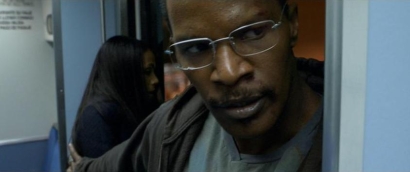
Max-as-Subject prepared to battle Vincent for control over his sense of Self
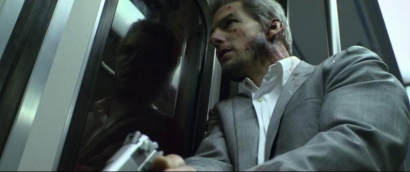
Vincent bloodied but not beaten as he prepares for his final confrontation with Max
The film’s climax consists of a chase in and outside of the office building of Annie Farrell (Jada Pinkett Smith), the prosecuting attorney on the case against the man who hired Vincent and the fifth and final target on Vincent’s hit list. The prophetic nature of this chase is discernible in the way it brings the diegesis “back” to the M.T.A., which “reinforce[s] an urban way of life” (Sanders, 2003: 282) and, in Vincent’s mind, represents the personification of the anonymity and indifference of modern urbanity. Trapping Max and Annie at the back of the train, Vincent readies himself for the kill.
Max, having assumed his role as the film’s proactive hero, learns the painful truth of war: It is “agonizing, and it involves sacrifice,” but it is “the duty of every American man to vanquish ‘evil’ from the earth, wherever it may hide, and whatever form it may take” (Saunders, 2009: 202), an especially resonant philosophy to the post-9/11 spectator and a relevant point to be made considering Max’s shift into a truly ethical subject committed to doing his duty and seeing things through to the end. With Vincent in pursuit, Max puts himself in the line of fire to protect Annie, unloading his gun at Vincent at the same time Vincent fires at him. Perfectly in keeping with Vincent’s nihilism and his views on the absurdity of life and death, it is by mere chance that Vincent gets shot and Max does not, the lights on the train going out as Max closes his eyes and the two empty their guns at each other.
Realizing he is no condition to complete his mission, Vincent simply takes a seat on the train, his stupefaction yielding to contentment reminiscent of Travis’ chilling bemusement subsequent to his massacring the brothel at the end of Taxi Driver. Monastically having acquiesced to his situation, Vincent recalls the story about the corpse on the M.T.A. that he told to Max at the beginning of the film, the story that now mirrors his exact situation, sardonically asking, “Think anybody will notice?”
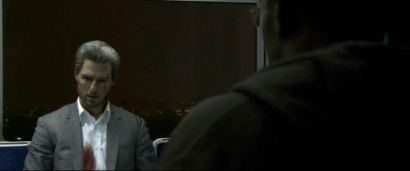
This episode confirms, for Vincent, the validity of his nihilism
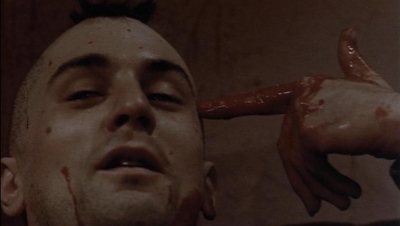
Similarly, Travis acquiesces to his fate at the end of his mission
In relation to the incoherence of the Vincent character, it is significant that Max, watching as Vincent slowly dies, has the same sense of confusion as we do at this denouement. On the one hand, we cannot, in good conscience, wish for the death of Max and Annie, two innocents thrown into the urban frontier and forced to contend with the wrath of Vincent, but on the other hand, witnessing Vincent’s demise is far from a cause for celebration. As he sits down across from Vincent right before he dies, Max off-handedly remarks that they are almost at the next station, leaving hanging the offer to maybe get him help. The very fact that this is implicit in the statement speaks to Max’s inability to reconcile his fear of and sympathy for Vincent, once again mirroring the very same irreconcilability we are feeling as we watch Vincent take his last breaths.
In spite of the traumatic position occupied by Vincent, we still identify with him as an ethical subject and feel sorry for him as he is paradoxically destroyed by his commitment to his ethics. The mantra Vincent continually repeats throughout the film, “I do this for a living,” highlights his inability to retreat from his ethical duty. By being a “true” ethical narcissist, he has become a monster [3]. While we may appreciate the “beauty of pure functionality” displayed by the Terminator and Vincent, it is the absolute purity of this functionality, the extremes to which these subjects go, that is responsible for their downfall and for our ultimate disavowal of them. And yet, returning to the central theme of incoherence, we “can neither clearly reject him” nor can we “structure a coherent attitude to him” (Wood, 1986: 53), because to disavow Vincent is to disavow a part of ourselves.
In the end, what we are left with is the same thing that Max is left with, and that is the experience of confronting the nature of oneself and one’s known world. What one does with that experience cannot be prophesized, and indeed, Mann offers no clues as to what will happen to the surviving characters at the end of the film. Nor, significantly, does he give in to what Michael Little refers to as “cheap irony, as many other commercial filmmakers might have done [by showing] the surviving characters hail a cab, in order to begin their journey into their changed lives” (Little, 2004). “Instead,” as Little expounds,
They stagger to the street corner, huddled and scared and we then see a robotic subway train, like an impersonal, inanimate coffin, moving on into the distance along its routine track, oblivious to events, time or its lifeless cargo, which now means no more than one of its metal wheels or plastic seats. This is a felicitous final image to fascinating, intelligent, dark and beautiful, thought birthing cinema (Little, 2004).
Another reviewer sees implicit in the film’s ending a note of optimism, something that is, as previously discussed, typically absent in film noir yet expected in a film operating at a level of such incoherence as Collateral. J.D. Lafrance notes the way the characters in Collateral are “alienated by a cold and uncaring city” (Lafrance, 2004), but even so, Lafrance sees light at the end of the tunnel in the form of character transformation, something Lafrance asserts is very much archetypical Michael Mann. According to Lafrance, “in order to have any chance of surviving the night with Vincent, Max must change from being a passive character to one that takes an active role in determining his own fate” (Lafrance, 2004). As discussed at length in this essay, such a transformation is indeed achieved in the form of Max’s actualization as an ethical subject through his dialectical relationship with the traumatic analyst figure in Vincent. In Lafrance’s mind, such an actualization has Max succeeding in doing what, vis-à-vis Wood, Americans in the 1970s failed to do. Max refused to acquiesce to Vincent’s nihilism and issued in a revolution; he created a coherent and comprehensive alternative to the society that was alleged to be in a state of advanced disintegration. The question that remains now is whether or not we current, post-9/11 Americans can do the same.
Endnotes
1 Here, the significance of the body crashing onto the roof of Max’s cab is in the way Max’s world, just like his windshield, is literally shattered in this traumatic intrusion of reality. Destroyed is the serene atmosphere created previously by the inclusion of a “meet-cute” sequence between Max and prosecuting attorney Annie Farrell (Jada Pinkett Smith), a character whose import is not fully known until the film’s climax. This event can also be seen allegorically as analogous to the terrorists smashing planes into the World Trade Center, shattering the illusion of conflict being external to American life.
2 For reviews of Arnold: Schwarzenegger and the Movies, see Kyle Barrowman, “Arnold: Schwarzenegger and the Movies,” Film Monthly (2011), and Joseph Arton, “Arnold Schwarzenegger and the Movies,” Scope: An Online Journal of Film and TV Studies 19 (2011).
3 Žižek takes up this idea in an analysis of Darth Vader that can be found in The Parallax View, 100-103.
Works Cited
Anderson, Michael J. “Before Sunrise, or Los Angeles Plays Itself In a Lonely Place.” Senses of Cinema. 2004. Web.
Atkinson, Michael. “Mann on Fire.” The Village Voice. 2004. Print.
Cadbury, William. “Film Interpretation: Theory and Practice.” Film Criticism: A Counter Theory. By William Cadbury and Leland Poague. Ames: Iowa State UP, 1982. 189-264. Print.
Ebert, Roger. “Collateral.” Chicago Sun-Times. 2004. Web.
French, Sean. The Terminator. London: British Film Institute, 1996. Print.
Glaister, Dan. “Cut to the Chase.” The Guardian. 2004. Print.
Knapp, Larry. “Tony Scott and ‘Domino’- Say Hello (and Goodbye) to the Postclassical.” Jump Cut. Spring 2008. Web.
Lafrance, J.D. “Collateral.” The Film Journal. 2004. Web.
Little, Michael. “Pure Professionalism: A Mann Made Picture (Thoughts on Collateral).” The Film Journal. 2004. Web.
McGowan, Todd. The Real Gaze: Film Theory After Lacan. Albany: State University of New York, 2007.
Sanders, James. Celluloid Skyline. New York: A.A. Knopf, 2003. Print.
Saunders, Dave. Arnold: Schwarzenegger and the Movies. London and New York: I.B. Tauris, 2009. Print.
Wood, Robin. Hollywood from Vietnam to Reagan. New York: Columbia UP, 1986. Print.
Žižek, Slavoj. Tarrying with the Negative: Kant, Hegel, and the Critique of Ideology. Durham: Duke University Press, 1993. Print.
Žižek, Slavoj. The Žižek Reader. Ed. Elizabeth Wright and Edmond Leo Wright. Oxford: Blackwell, 1999. Print.
Žižek, Slavoj. The Parallax View. Cambridge: MIT Press, 2006. Print.


